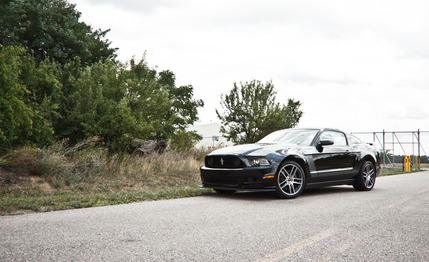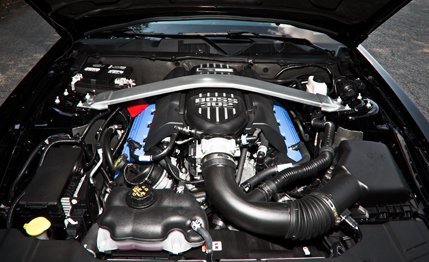
 Instrumented Test
Instrumented Test


Two. That’s how many times this author looked underneath the 2013 Boss 302 Laguna Seca to make sure some crafty Ford employee hadn’t replaced the solid axle with a fancy-pants independent-rear-suspension setup. It’s not as if the Boss were suddenly devoid of axle hop or radically more skilled at navigating off-camber curves and uneven pavement than are other current Mustangs, but Ford has finessed the stick axle to the point where it no longer spoils an otherwise good time. Still, we wanted to be 100 percent sure the company hadn’t slipped us a ringer.
You’ve Got the Power, Stand Up and Shout
Similar incredulity is inspired by the 444-hp, 5.0-liter V-8 that lives under the hood. Unchanged from the unit in last year’s reborn Boss 302/Laguna Seca models—they joined the Mustang GT on our 2012 10Best Cars roster—it still represents the pinnacle of the breed. (You can order the Boss’s engine à la carte if you wish.)


If you’ve kept up with the current-gen Boss 302 at all, you’re undoubtedly familiar with its trick exhaust system. Like any red-blooded enthusiast, we pulled this Laguna Seca model’s exhaust restrictors immediately upon its arrival for maximum beast mode. The roar is visceral and intimidating and remains utterly melodious from the depths of idle to the V-8’s 7500-rpm redline. Pin the right pedal, and the sound corrupts like an opiate; one sample and you’re hooked, doomed to spend the rest of your days cruising dark streets and freeway tunnels looking for a suitable place to take another hit of that sweet, thunderous elixir. Drop out of the gas, and the bellow retreats to staccato bursts of burbles and pops, the engine pulsing against backpressure like Zeus casually farting in his Olympian hot tub.


Beyond its sound, the engine pulls strongly across virtually the entire tach; it spins any one of six forward ratios selected via a round black shift knob that perfectly fits both your hand and the vibe of the car. At about half the circumference of a billiard ball, it’s one of the many small details that Ford got right.
X Marks the Spot
Look behind the Laguna Seca’s Recaro front seats, and you’ll find, well, nothing. Okay, so that’s not completely true. A beefy, chassis-stiffening tubular X-brace takes up residence where rear seats would be found in lesser Mustangs. (For 2013, the brace is finished in gray, toned down from the garish red used last year. The vaguely cheesy contrasting exterior roof colors have been eliminated, too.) Said to improve rigidity by up to 10 percent, the brace is joined by a larger rear stabilizer bar, manually adjustable dampers with Laguna Seca–specific valving, and higher spring rates to deliver reflexes one notch sharper than those of a standard Boss. The upshot of all this hardware is delightfully neutral handling and understeer as scarce as bow ties in Dearborn.
Laguna Secas have a 3.73:1 rear axle ratio and a Torsen limited-slip rear differential to make the most of all 444 ponies, but get too eager on launch, and it’s still easy to induce some of the aforementioned axle tramp. (Note to self: Axle Tramp is a great name for a retro-glam ’80s hair-metal band.) As our test driver noted at the track, ambient temperatures during one of Michigan’s many heat waves this summer might have affected grip and power, as the skidpad and acceleration numbers—0.96 g and 12.7 seconds in the quarter-mile—seemed to be a little lower than they ought to have been for this racetrack-oriented model. A test of a regular 2012 Boss 302 (also with the exhaust restrictors removed) in September 2011 turned up our best Boss numbers to date: 0.95 g of grip and a quarter-mile time of 12.4 seconds.